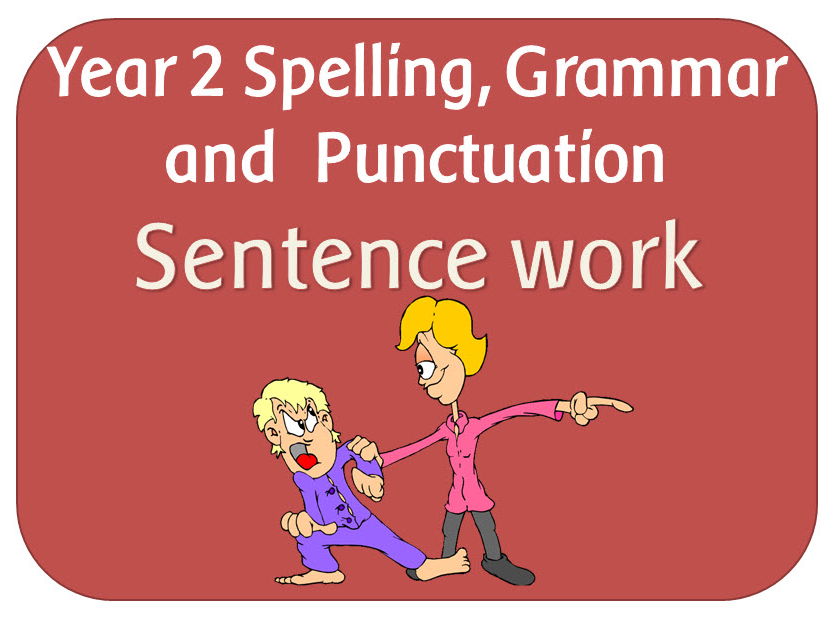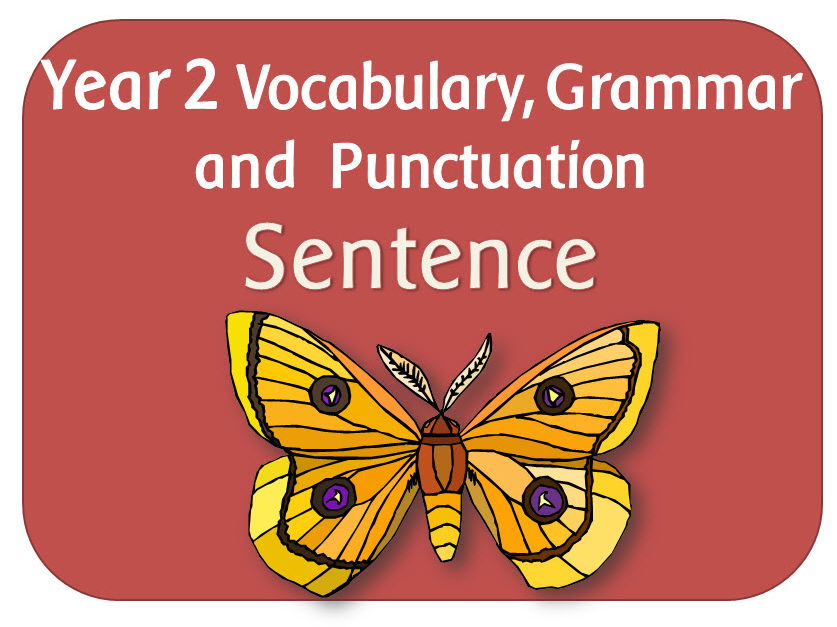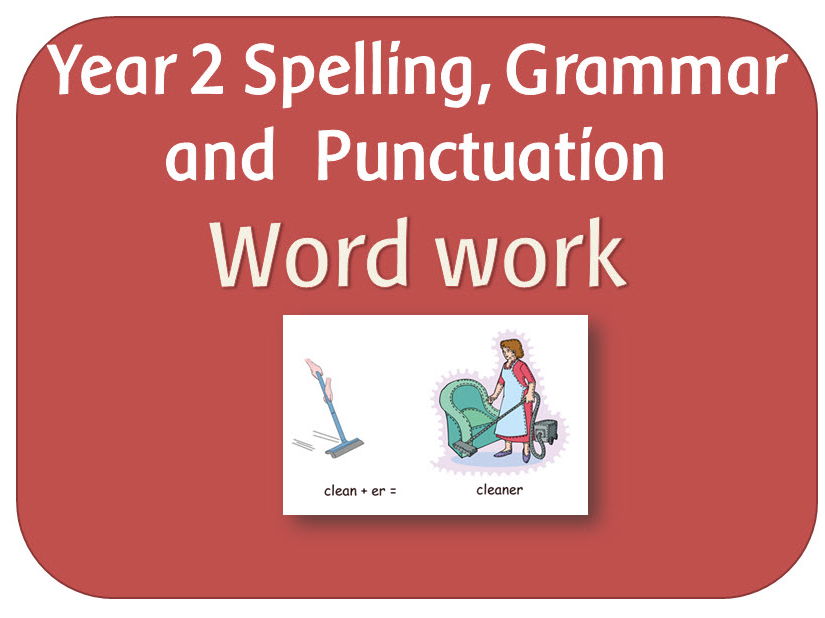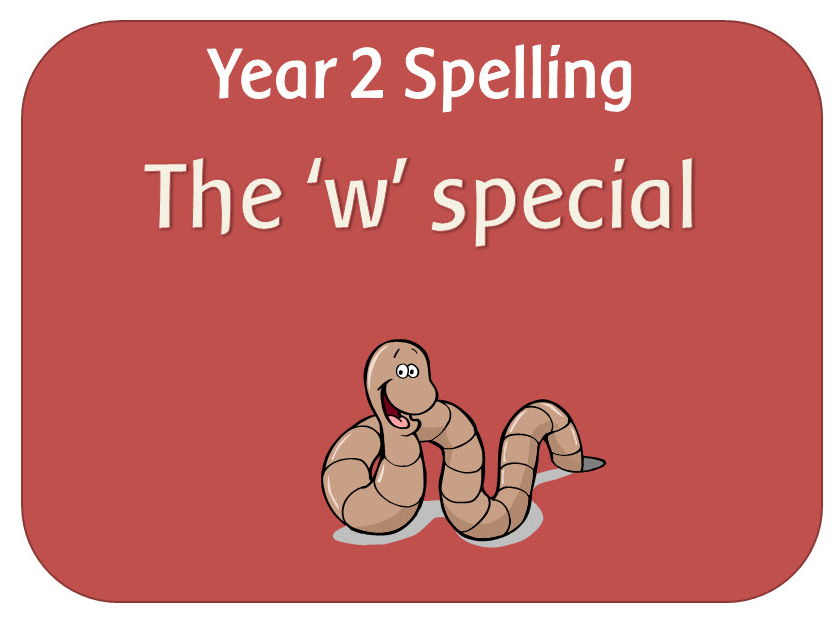
404Uploads
1075k+Views
684k+Downloads
English

SPaG Year 2 Sentences: Statements, questions, exclamations or commands
A lesson explainint the difference between statements questions exclamations and commands, with 2 activities.
DIFFERENT TYPES OF SENTENCES
POWERPOINT
Explains the difference between a statement, question, exclamation and a command, and how the grammatical patterns vary
ACTIVITIES
Different types of sentences - writing an advertisement x 2

SPaG Year 2 Sentence: Expanded noun phrases for description and specification
A PowerPoint demonstrating how to add adjectives to make expanded noun phrases. Ends with different pictures for the children to add words to describe and specify.

Subordination and co-ordination powerpoint, worksheets and posters: SPaG Year 2 Sentence
A PowerPoint lesson explaining what subordination and co-ordination are with accompanying worksheets and posters, designed to teach the Y2 Sentence objectives.
The set contains:
POWERPOINT:
Subordination and coordination
A 7 page PowerPoint explaining how to connect sentences and clauses using subordination (when, if, that and because) and co-ordination (using or, and or but.)
It gives examples of how to use them in sentences then gives sentence starters for the children to complete using the words above.
ACTIVITIES / WORKSHEETS:
Co-ordination writing sheets x 4: Each sheet has a different picture. The children have to write sentences using the words and, but and or.
Subordination worksheets x 4: Each sheet has a different picture. The children have to write sentences using the words when, if, that and because
DISPLAY:
Two posters explaining subordination and co-ordination with examples and a heading.

SPaG Year 2 Word: -er and -est in adjectives and -ly to turn adjectives into adverbs
2 powerpoint lessons and a worksheet:
THE USE OF LY TO TURN ADJECTIVES INTO ADVERBS
POWERPOINT
Using ly to turn adjectives into adverbs: Explains what adverbs are and how to make them by adding ly to adjectives.Gives a list of words to add ly to.
ACTIVITY
Making adverbs worksheet: Writing sentences with adverbs
USING THE SUFFIXES ER AND EST IN ADJECTIVES
POWERPOINT
Suffixes er and est as comparatives: Explains how they change the meaning of words. Gives a list of words to add the suffixes to and think of sentences with them in.

SPaG Year 2 Word: Formation of adjectives using suffixes such as -ful or -less
6 powerpoints looking at adding different suffixes to make adjectives, plus a worksheet:
POWERPOINTS: The first three resources below explain what adjectives are, and what each suffix does to the meaning of words it is added to. They end with a list of words to add the suffix to, and explain how the meaning of the word has changed.
Formation of adjectives by adding ful
Formation of adjectives by adding less
Formation of adjectives by adding y
Formation of adjectives ful and less recap: Goes over the two suffixes then ends with an activity to change words by adding ful or less
Adding suffixes to words in sentences: Pictures to encourage the children to make adjectives from root words.
Think of adjectives: Different pictures for the children to look at and think of describing words using the suffixes ful y and less.
ACTIVITIES
Formation of adjectives worksheet: Writing sentences to describe pictures

SPaG Year 2 Word: Formation of nouns using suffixes such as -ness and -er and by compounding
The pack recaps what suffixes are and explains how to form nouns using the suffixes -er and -ment and by compounding. Also included is a list of compound words and 2 sets of jigsaw cards.
INTRODUCTORY POWERPOINT
What are suffixes: Explains what they are and what meaning they add to words
FORMATION OF NOUNS USING SUFFIXES: er, ment, ness
POWERPOINTS: The three resources below recap on what a suffix and a noun is, then explain what each suffix means, and what effect it has on words. They ask the children to add the suffix to words and explain how the meaning has changed.
Formation of nouns using the suffix er
Formation of nouns using the suffix ment
Formation of nouns using the suffix ness
ACTIVITIES
Jigsaw cards er ness and ment - to make words
FORMATION OF NOUNS BY COMPOUNDING:
POWERPOINT
Formation of nouns by compounding: Explains what compound nouns are, then gives lists of words to make new compound nouns.
ACTIVITIES
Creating compound words: For the children to make words
Compound word list

SPaG Year 2 Spelling: Common Exception words
Spelling resources to teach the statutory requirements in Appendix 1 of the English curriculum:
COMMON EXCEPTION WORDS
POWERPOINT RESOURCES: The following PowerPoint lessons contain groups of words with similar spellings. Each grapheme-phoneme correspondence that is new to the children (depending upon phonics programme used) is introduced and explained. The children then are given opportunities to read and then write the words.
CEW 1 – door poor floor
CEW 2 – find kind mind etc
CEW 3 – most only both etc
CEW 4 – after fast last
CEW 5 – every, everybody, even
CEW 6 –great break steak
CEW 7 –move prove improve
CEW 8 – sure sugar
CEW 9 - who whole
CEW 10 - any many
CEW 11 - could would should
The following PowerPoint lessons contain individual common exception words. There are examples of different strategies the children can use for remembering how to spell the words, such as using mnemonics, saying the word as it is spelt, using the look write cover check method and highlighting the tricky part. Each strategy is demonstrated visually.
CEW Spelling strategies PEOPLE
CEW Spelling strategies BEAUTIFUL
CEW Spelling strategies AGAIN
CEW Spelling strategies BECAUSE
CEW Spelling strategies BUSY
CEW Spelling strategies CHRISTMAS
CEW Spelling strategies CLOTHES
CEW Spelling strategies EYE
CEW Spelling strategies HALF
CEW Spelling strategies HOUR
CEW Spelling strategies MR & MRS
CEW Spelling strategies PARENTS
CEW Spelling strategies PRETTY
CEW Spelling strategies WATER
WORKSHEETS:
Spelling activity sheets - A variety of pdf sheets that can be used for different spelling activities. They include:
Acrostic poems
Bubble words
Colourful words
Cut out words
Look write cover check spelling sheet
Rainbow spellings
Shape words
Silly Sentences
Spelling with both hands
Stories with spellings
Word search with spellings
Words in words
Writing a poem
Writing fun
TEACHER RESOURCES
Y2 Spelling Appendix planning - Common Exception Words: An adaptable outline plan
Word List - With relevant words

SPaG Year 2 Spelling: Homophones and near homophones
Resources to teach a variety of homophones and near homophones
POWERPOINT
Introduction to homophones: Explains why the English language has so many homophones
Year 2 Homophones with pictures: Includes be/bee, been/been, bare/bear, blew/blue, for/four, here/hear, knew/new, night/knight, know/no, one/won, pair/pear, plain/plane, quite/quiet, red/read, right/write, sea/see, where/wear, so/sew/saw, some/sum, son/sun, tail/tale, their/they're/there, through/threw, to/too/two, week/weak and which/witch
Writing sentences with homophones: Activity for sentence writing
The following powerpoints look at individual pairs/trios of homophones, explaining the differences, and giving sentences at the end to choose which one is the correct word:
Homophones they're their there
Homophones hear and here
Homophones son and sun
Homophones to two and too
Homophones be and bee
ACTIVITIES
Homophone cards with pictures
Homophone cards (just words)
TEACHER RESOURCES
Y2 Spelling Appendix: An adaptable outline plan
Word List - With relevant words

SPaG Year 2 Spelling: Words ending -tion
Resources to teach the spelling rules for words ending in tion
POWERPOINT
Words ending tion: Introduction to the 'shun' sound spelt tion as the most common spelling, with a spelling activity.
ACTIVITIES
Word wheel: making words ending in tion
Word search: Words ending in tion
Although every effort has been made to check wordsearches for unintentional inappropriate words, it is recommended that teachers double check them before giving to children.
TEACHER RESOURCES
Y2 Spelling Appendix Words ending in tion: An adaptable outline plan
Word List - With relevant words

SPaG Year 2 Spelling: Possessive apostrophes activities and display
POWERPOINT
Apostrophes for possession: Explains how to use them, and gives sentences to reword, using apostrophes for possession.
ACTIVITY
Worksheet - Possessive apostrophes
DISPLAY
Single possessive apostrophes posters
TEACHER RESOURCES
Y2 Spelling Appendix - Possesive apostrophes: An adaptable outline plan

SPaG Year 2 Spelling: Contractions
Resources to teach the spelling rules for: The use of apostrophes in contractions
POWERPOINT
Introduction to contractions: Explains what contractions are and shows examples of them in newspaper headlines. It then demonstrates how different contractions are formed. It ends with an oral activity for the children to say the long form of the contraction in each sentence.
Writing contractions: A writing activity where the children have to change the words into contractions
Changing contractions to the full form: As above, but the other way round
Its or it’s: Explains the differences, with sentences for the children to guess which is correct
Your or you’re: As above
ACTIVITIES
Cards - Sentences with contractions: The children can rewrite them in the long form
Cards - Contractions snap
Show me cards - its or it’s
Show me cards - your or you’re
Worksheet - Change the words into contractions
Worksheet - Change the contractions into the long form
Worksheet - Complete the contraction matrix
Worksheet - Find the contractions in the story
Newspaper report
TEACHER RESOURCES
Y2 Spelling Appendix planning - Contractions: An adaptable outline plan
Word List - With relevant contractions

SPaG Year 2 Spelling: The /ʒ/ sound spelt s
The powerpoint introduces the phoneme zh as s and gives examples of words and pictures. At the end there is an opportunity for the children to spell the words. The pack also includes a word list, worksheet and outline planning.

SPaG Year 2 Spelling: The /ɒ/ sound spelt a, or and ar after w (and qu)
A set of resources looking at the spelling guidelines for:
The /ɒ/ sound spelt a after w and qu
The /ɜ:/ sound spelt or after w
The /ɔ:/ sound spelt ar after w
There is a powerpoint for each sound, a bingo game containing all the spellings, plus a word list and outline plan.

SPaG Year 2 Spelling: The /i:/ sound spelt –ey
A powerpoint lesson looking at words such as key, monkey, donkey etc. The pack also includes a word list, wordsearch, crossword and outline planning.

SPaG Year 2 Spelling: The /ʌ/ sound spelt o
A powerpoint lesson looking at words such as other, mother, brother or nothing. The pack also includes a word list, wordsearch, word cards and outline planning.

SPaG Year 2 Spelling: The /ɔ:/ sound spelt a before l and ll
A set of resources to teach children that the /ɔ:/ sound (‘or’) is usually spelt as a before l and ll.

SPaG Year 2 Spelling: A recap of the rules for adding suffixes
A powerpoint looking at the rules learnt so far for adding suffixes beginning with vowel letters.

SPaG Year 2 Spelling: Adding –ing, –ed, –er, –est and –y to words of one syllable
Resources to teach the spelling rules for: Adding ing, ed, er, est and y to words of one syllable ending in a single consonant letter after a single vowel letter
POWERPOINTS
Adding suffixes to one syllable cvc words: Explains what a root word and a suffix is, and shows the addition of -ed and -ing, explaining the spelling rule, and the rule for words ending in c and x. It ends with a quick write activity to add ing or ed and er, est or y to different root words.
Quick write - Adding ed and doubling
Quick write - Adding ing and doubling
Recap of the three suffix rules (includes adding suffixes to words ending in y following a consonant, and words ending in e following a consonant, plus the doubling rule)
Quick write activities show firstly the the root word, then how it changes/stays the same when the suffixes are added.
ACTIVITIES
Words ending in a consonant then e matrix: to fill in
TEACHER RESOURCES
Y2 Spelling Appendix: Adding suffixes and doubling: An adaptable outline plan
Word List - With relevant words

SPaG Year 2 Spelling: Adding the endings ing, ed, er, est and y to words ending in consonant / -e
Resources to teach the spelling rules for: Adding –ed, –ing, –er and –est to a root word ending in –e with a consonant before it
POWERPOINTS
Adding suffixes to words ending in e: Explains what a root word and a suffix is, and shows the addition of -ed and -ing, explaining the spelling rule. It ends with an activity to add ing or ed and er, est or y to different root words.
Quick write - Adding ed to verbs ending in e
Quick write - Adding ing to verbs ending in e
Quick write - Adding er to words ending in e
Quick write - Adding est to words ending in e
Quick write - Adding y to words ending in e
Quick write activities show firstly the the root word, then how it changes/stays the same when the suffixes are added.
ACTIVITIES
Words ending in a consonant then e matrix: to fill in
TEACHER RESOURCES
Y2 Spelling Appendix: Adding suffixes to words ending in e: An adaptable outline plan
Word List - With relevant words ending in e with a consonant before it

SPaG Year 2 Spelling: Adding –es to nouns and verbs ending in –y
3 powerpoint lessons looking at how to add -es to nouns and verbs, with activities, planning and word list.
ADDING -ES TO NOUNS:
POWERPOINTS
Adding es to nouns ending in y
Plurals recap - adding es
ACTIVITIES
Adding es to nouns ending in y worksheet
Singular and plural cards
ADDING -ES TO VERBS:
POWERPOINT
Adding es to verbs ending in y
ACTIVITIES
Adding es to verbs ending in y worksheet
TEACHER RESOURCES
Y2 Spelling Appendix: Adding es to nouns and verbs ending in y- An adaptable outline plan
Word List - With relevant words ending in y.




















